In a bold move to redefine global connectivity, Amazon has officially launched the first batch of satellites for its ambitious Project Kuiper, marking a significant step in the battle for satellite-based internet. The goal of Project Kuiper is to create a massive constellation of internet-beaming satellites aimed at providing broadband access to underserved regions worldwide, effectively taking on SpaceX’s Starlink, which has already established a formidable presence in this burgeoning market.
The Launch of Project Kuiper
On April 28, 2023, Amazon successfully launched 27 of its Kuiper satellites atop an Atlas V rocket from Cape Canaveral, Florida. This event not only marks a critical milestone for Amazon but also sets the stage for intense competition with SpaceX’s Starlink, which has already deployed over 7,000 satellites and serves millions of customers globally.
The launch unlocks the first phase of a projected fleet of 3,200 satellites that will orbit at a lower altitude compared to traditional geostationary satellites, designed to ensure lower latency and faster internet speeds. The initiative is seen as not only a technological challenge but also a strategic maneuver to capture a share of the lucrative satellite-driven internet market.
A Complex Undertaking
Creating a satellite constellation of such magnitude requires intricate planning and substantial investment. Reports suggest that initial development for Project Kuiper could cost Amazon upwards of $20 billion. This staggering amount reflects both the scale of the endeavor and the competitive pressure exerted by SpaceX’s already established Starlink network.
According to financial analysts, Amazon might face challenges in catching up with SpaceX, which has accumulated significant experience and customer base over the years. As Craig Moffett from MoffettNathanson points out, many observers wonder if it is too late for Amazon to meaningfully compete in this space.
Technical Competitions
Project Kuiper’s satellites will aim to provide internet connections in remote regions lacking traditional broadband infrastructure. Operating at around 280 miles above Earth, these satellites will leverage low Earth orbit (LEO) advantages similar to those already employed by Starlink, which orbits at around 340 miles.
Yet the technical demands are high. Each satellite must collaborate efficiently to maintain connectivity. Amazon aims to deploy thousands more satellites in rapid succession to meet its operational goals set by the Federal Communications Commission (FCC). To sustain operations, Amazon must have half of its planned constellation in orbit by July 2026.
Challenges Ahead
Despite its potential, Project Kuiper faces substantial hurdles. The anticipated cost of deploying and maintaining the satellites, estimated between $1 billion to $2 billion annually after initial deployment, raises questions about profitability.
Additionally, with the rapid proliferation of satellites in low Earth orbit, concerns about space debris and satellite collisions are escalating. Experts highlight that as more satellites operate in overlapping orbits, the likelihood of close approaches increases, necessitating advanced systems for collision avoidance.
Given that Starlink already employs complex navigation systems to prevent collisions, Amazon will need to develop similar capabilities for Project Kuiper, or risk catastrophic events that could exacerbate the existing challenges in space environments.
The Geopolitical Landscape
On the geopolitical front, Elon Musk’s presence in the satellite internet space has raised concerns. Past incidents wherein Starlink services were employed in war zones have put SpaceX in the spotlight, prompting discussion around the potential consequences of providing internet connectivity in sensitive areas.
With Amazon’s Project Kuiper, Jeff Bezos may present a different public image, bolstered by a less politically charged approach than Musk’s. This shift could appeal to international customers who are wary of the repercussions of relying on SpaceX in contentious circumstances.
Wider Implications for Society
Beyond corporate competition, Project Kuiper represents a broader societal ambition—providing internet access to education, commerce, and communication in previously unreachable locations. This endeavor promises to open markets and enhance productivity in developing regions.
However, as the new satellites take shape, scientists are wary of the ecological and observational impacts of such mega constellations on both the cosmos and terrestrial environments. Bright streaks across the night sky disturb astronomical observations, leading to apprehension that unchecked satellite growth will irrevocably change our view and understanding of the universe.
Regulatory frameworks are lacking, raising concerns regarding sustainability and the rapid changes engulfing low Earth orbit.
Conclusion: An Evolving Race
Ultimately, Amazon’s Project Kuiper presents an exciting yet complex chapter in the future of global connectivity and space operations. With universal internet access on the horizon, the implications for human life on Earth could be profound. However, the race against established entities like SpaceX necessitates swift innovation, investment, and careful navigation through the challenges of space sustainability.
The unfolding developments around Project Kuiper will likely impact not only market dynamics but also ignite discussions on space governance, technological ethics, and our relationship with the cosmos. As the competition heats up, both companies will need to be attuned to global challenges while innovating for the future.
In this new frontier, the final outcome remains uncertain, but one thing is clear: the race for space and connectivity is just beginning.

